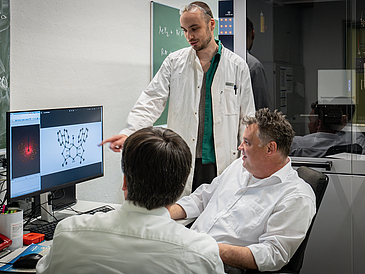"Our finding is a great success for foundation research. Chemistry textbooks will have to be rewritten," states Professor Jens Beckmann, head of the research team. "We have shown that it is possible to control these highly reactive compounds in the laboratory. This will not only improve our understanding of chemistry, but also holds potential for developing new innovative catalyst systems.”
Life Span Originally in Nanosecond Range
The isolation of nitrenes was previously impossible due to the fact that these compounds react very quickly with other substances and normally only remain stable for tiny fractions of a second. The breakthrough was achieved by the scientists building a kind of protective shield around the reactive nitrogen atom, which seals it off from other substances in the environment. "Figuratively speaking, we have built two walls around the reactive nitrogen atom that serve to shield it," explains Professor Beckmann. Chemists call this protective mechanism kinetic stabilization.
To determine the exact structure of the isolated nitrene, the researchers used a special method called X-ray structure analysis. This revealed that the nitrogen atom in this case is only connected to a single carbon atom, whereas nitrogen normally forms three bonds. "The X-ray structure analysis gave us amazing insights," says Beckmann. "The nitrogen atom in our nitrene is only bonded to a single carbon atom, which is extremely unusual and leads to a so-called electronic triplet ground state. This unique structure gives the nitrene special magnetic properties known as paramagnetism."
Discovery Could Lead to New Developments in Catalyst Research
The significance of this discovery goes far beyond foundation research. Stable nitrenes could be used as novel ligands in homogeneous catalysts, for example in the chemical industry, in order to make chemical reactions more efficient and save energy.
Beckmann emphasizes that interdisciplinary research was the key to success. "Although the origins lie in chemistry, it was only through collaboration with the geo- and material sciences that we were able to understand the magnetic properties and ultimately make this revolutionary discovery." In addition to Professor Beckmann, the authors of the study are: Marvin Janssen, Thomas Frederichs, Marian Olaru, Enno Lork, and Emanuel Hupf.
Further Information:
https://www.uni-bremen.de/beckmann (in German only)
https://www.science.org/doi/10.1126/science.adp4963
Contact:
Prof. Dr. Jens Beckmann
University of Bremen
Faculty 02: Biology / Chemistry
Phone: +49 421 218-63160
Email: j.beckmannprotect me ?!uni-bremenprotect me ?!.de

